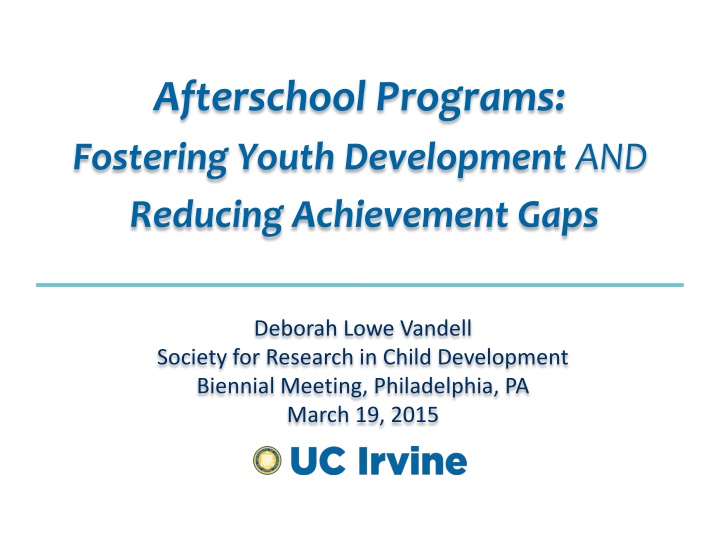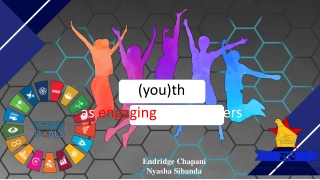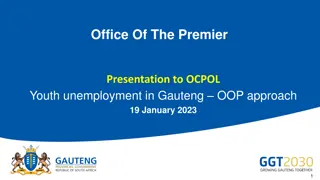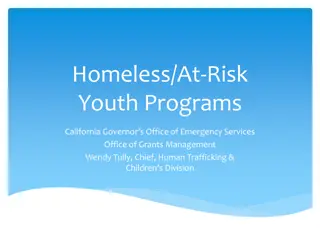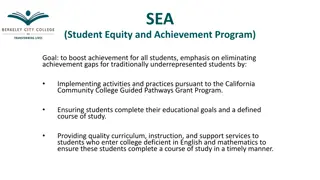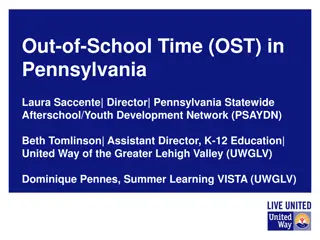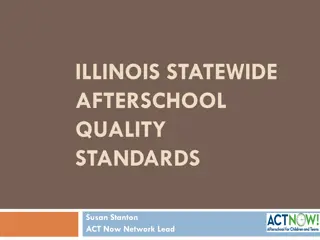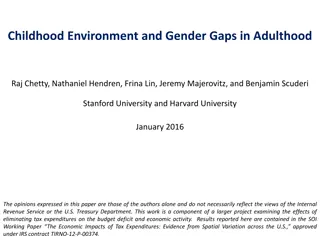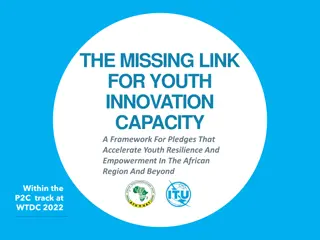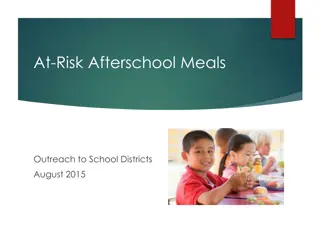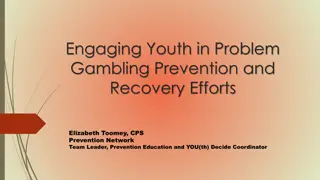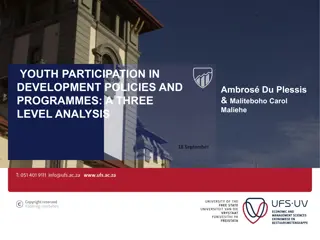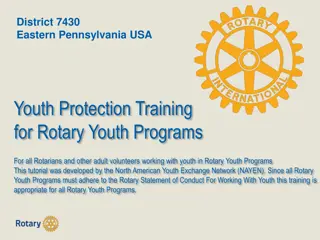Afterschool Programs: Fostering Youth Development and Reducing Achievement Gaps
Key ingredients and effects of high-quality afterschool programs are explored in this research summary, highlighting the importance of program quality, duration, and participant outcomes. The study emphasizes engaging activities, choice, relationships with staff and peers, as well as short-term and long-term positive impacts on social and academic behaviors.
Download Presentation

Please find below an Image/Link to download the presentation.
The content on the website is provided AS IS for your information and personal use only. It may not be sold, licensed, or shared on other websites without obtaining consent from the author.If you encounter any issues during the download, it is possible that the publisher has removed the file from their server.
You are allowed to download the files provided on this website for personal or commercial use, subject to the condition that they are used lawfully. All files are the property of their respective owners.
The content on the website is provided AS IS for your information and personal use only. It may not be sold, licensed, or shared on other websites without obtaining consent from the author.
E N D
Presentation Transcript
Afterschool Programs: Fostering Youth Development AND Reducing Achievement Gaps Deborah Lowe Vandell Society for Research in Child Development Biennial Meeting, Philadelphia, PA March 19, 2015
Exciting Times 1. Key ingredients of powerful afterschool programming have been identified 2. Robust short-term effects are well documented 3. Evidence of meaningful long-term outcomes of afterschool programs 4. Emerging evidence that early child care and afterschool programs play unique and complementary roles
1. Key Ingredients That Make a Difference
Program Quality Key elements: Engaging, challenging, interesting activities; Choice & voice; Relationships with staff; Relationships with peers Program Intensity Hrs/wk & days/yr Program Duration Sustained participation over time
2. Robust Short-Term Effects of High-Quality Programs
Meta-Analysis Documenting Short-Term Effects of High- Quality Programs Durlak, Weissberg, & Pachan Social Outcomes 0.4 0.35 0.3 0.25 0.2 0.15 0.1 0.05 0 Self Perceptions (23 Studies) Positive Social Behaviors (36 Studies) Reduced Problem Behaviors (43 Studies) Reduced Drug Use (28 Studies) "SAFE" Programs "Other" Programs
Meta-Analysis Documenting Short-Term Effects of High- Quality Programs Durlak, Weissberg, & Pachan Social Outcomes 0.4 0.35 0.3 0.25 0.2 0.15 0.1 0.05 0 Self Perceptions (23 Studies) Positive Social Behaviors (36 Studies) Reduced Problem Behaviors (43 Studies) Reduced Drug Use (28 Studies) "SAFE" Programs "Other" Programs
Meta-Analysis Documenting Short-Term Effects of High- Quality Programs Durlak, Weissberg, & Pachan Academic Outcomes 0.30 0.25 0.20 0.15 0.10 0.05 0.00 School Achievement (20 Studies) Grades (25 Studies) School Attendance (21 Studies) School Bonding (28 Studies) "SAFE" Programs "Other" Programs
Meta-Analysis Documenting Short-Term Effects of High- Quality Programs Durlak, Weissberg, & Pachan Academic Outcomes 0.30 0.25 0.20 0.15 0.10 0.05 0.00 School Achievement (20 Studies) Grades (25 Studies) School Attendance (21 Studies) School Bonding (28 Studies) "SAFE" Programs "Other" Programs
More Evidence of Robust Short-Term Effects of High-Quality Programs Study of Promising Afterschool Programs (Vandell, Reisner, Pierce, & Bolt) Phase 1: A 3-year longitudinal study 35 high-quality programs, serving high-poverty communities in 8 states (CA, CT, MI, MT, NY, OR, RI, WI) Includes rural areas, small towns, mid-size cities, large cities 3,000 low-income, ethnically diverse elementary and middle school students
Features of High-Quality Programs Positive social relationships Staff-child relationships Relationships with peers Connections with families and communities Program content and activities Mix of academic and non-academic skill building activities Encouragement of student engagement Content delivery strategies Structured and unstructured learning opportunities Opportunities for mastery Opportunities for autonomy and choice These processes were assessed using observations, interviews, and survey instruments.
Findings: Study of Promising Afterschool Programs ELEMENTARY SCHOOL OUTCOMES ONE YEAR Program Only .17 Work habits Misconduct reductions .58 Math achievement .61
Findings: Study of Promising Afterschool Programs ELEMENTARY SCHOOL OUTCOMES ONE YEAR Program Only Program Plus .17 .36 Work habits Misconduct reductions .58 .43 Math achievement .61
Findings: Study of Promising Afterschool Programs ELEMENTARY SCHOOL OUTCOMES ONE YEAR TWO YEARS Program Only Program Plus Program Only Program Plus .17 .36 .24 .41 Work habits Misconduct reductions .58 .43 .66 .51 Math achievement .61 .52 .73
Findings: Study of Promising Afterschool Programs MIDDLE SCHOOL OUTCOMES ONE YEAR Program Only Program Plus Work habits Misconduct reductions .32 .31 Math achievement
Findings: Study of Promising Afterschool Programs MIDDLE SCHOOL OUTCOMES ONE YEAR TWO YEARS Program Only Program Plus Program Only Program Plus .20 .33 Work habits Misconduct reductions .32 .31 .56 .67 Math achievement .55 .57
Isolating Effects of Specific Quality Components: Changes in Adolescent Development Kataoka & Vandell (2013) Quality Composite Emotional Support from Staff .25 .23 .20 .18 .14 .13 .12 .08 .05 .03 Work Habits Task Prosocial Behaviors Social Skills w/ Peers Reduced Agression Persistence Reports by Classroom Teachers
3. Cumulative and Long-Term Effects of Afterschool Programs
Phase 2: Study of Promising Afterschool Programs (5 years later) Work Habits Task School Absences Misconduct GPA Persistence Program attendance days in phase 1 .08 .14
Phase 2: Study of Promising Afterschool Programs (5 years later) Work Habits Task School Absences Misconduct GPA Persistence Program attendance days in phase 1 .08 .14 Unsupervised time in phase 1 .16 .13
Phase 2: Study of Promising Afterschool Programs (5 years later) Work Habits Task School Absences Misconduct GPA Persistence Program attendance days in phase 1 .08 .14 Unsupervised time in phase 1 .16 .13 ELO phase 2 .19 .10 .16
Phase 2: Study of Promising Afterschool Programs (5 years later) Work Habits Task School Absences Misconduct GPA Persistence Program attendance days in phase 1 .08 .14 Unsupervised time in phase 1 .16 .13 ELO phase 2 .19 .10 .16 Unsupervised Phase 2 .13 .17 .22
Study of Early Child Care and Youth Development (SECCYD) Birth cohort (n = 1360, 23% low income; 25% students of color) recruited in 1991; 10 sites Children studied from birth through end-of-high-school Measures of out-of-school time participation collected from kindergarten to end-of-high-school Child cognitive, academic, social, and behavioral outcomes Extensive set of family, early child care, & school covariates
Participation in Afterschool Activities Linked to Academic Gains in Elementary School Consistent Participation Paper 1: K 1st (ECCRN, 2004) % epochs Student Outcomes G1 Math achievement .25
Participation in Afterschool Activities Linked to Academic Gains in Elementary School Consistent Participation Paper 1: K 1st (ECCRN, 2004) % epochs Student Outcomes G1 Math achievement .25 Paper 2: K 3rd (Pierce, Auger, % epochs & Vandell, 2014) G3 Academic grades .07 G3 Work habits .09
Participation in Afterschool Activities Linked to Academic Gains in Elementary School Consistent Participation Paper 1: K 1st (ECCRN, 2004) % epochs Student Outcomes G1 Math achievement .25 Paper 2: K 3rd (Pierce, Auger, % epochs & Vandell, 2014) G3 Academic grades .07 G3 Work habits .09 K 5th G5 Academic grades .07 G5 Work habits .11 G5 Math achievement % epochs .09
K-3 Participation: Narrowing the math achievement gap in GRADE 3
K-5 Participation: Narrowing the math achievement gap in GRADE 5
Long-term Relations between Quality & Intensity of Middle School Activities and High School Functioning Li & Vandell (2013) Grade 6 Activities High School Outcomes Quality of Activities Confident/Assertive .09 Substance use .08 Externalizing problems .06 Internalizing problems .08 Intensity Hours/week Confident/Assertive .08 Higher math achievement .06
4. Contrasting the Effects of Early Childhood and Afterschool Programs
Historically, ECE and afterschool researchers have worked in their own silos. Separate communities of practice also exist (for the most part) among practitioners and advocates who focus on one developmental period. This needs to change
Examining Long-Term Effects of Both ECE and OST Vandell, Pierce, Auger, & Lee (2014) Because of its design, the SECCYD is well suited to assessing BOTH early child care and afterschool experiences. Early Child Care Measures: Quality, Hours, Type Out-of-School Time Measures: Participation Epochs Academic and social-behavioral outcomes Extensive covariates (parenting, home, income, parent education, parent depression, PPRT)
Making a Case for Early Childhood AND Afterschool Programs K-5Consistent Participation Performance at Age 15 Quality of Early Childcare .07 .07 Math Achievement
Making a Case for Early Childhood AND Afterschool Programs K-5Consistent Participation Performance at Age 15 Quality of Early Childcare .07 .07 Math Achievement .08 .08 Reading Comprehension
Making a Case for Early Childhood AND Afterschool Programs K-5Consistent Participation Performance at Age 15 Quality of Early Childcare .07 .07 Math Achievement .08 .08 Reading Comprehension .12 Impulse Control
Making a Case for Early Childhood AND Afterschool Programs K-5Consistent Participation Performance at Age 15 Quality of Early Childcare .07 .07 Math Achievement .08 .08 Reading Comprehension .12 Impulse Control .11 Assertive/Confident
Final Reflections Unprecedented opportunities for afterschool programs to make a difference Afterschool programs are linked to a wide array of academic, social, and behavioral outcomes For these benefits to be realized, activities have to be of high quality, of sufficient intensity, and sustained over time. Early childhood and afterschool programs both play important roles in children s development and both are needed.
Increasing Opportunity Gap: Spending on enrichment (1972-2008) Duncan and Murnane (2011). Whither Opportunity?
Final Reflections Low-income youth are less likely to have access to afterschool enrichment programs, even though these youth may benefit most from these programs These findings underscore the potential value of expanding investments in high quality programming for low-income youth
